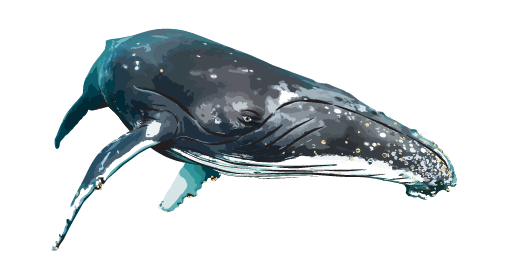
Whale Songs Decoded
Yaps and fin slaps, growls and groans—whales use a wide range of sounds to communicate. But only five whale species are known to sing, with humpbacks the unrivaled musical masters of the sea. As juveniles, male humpbacks start picking up songs in bits and segments, listening to their peers in a form of social learning (females vocalize but don’t sing). Once they master a song, it changes slightly, eventually completely, as the population rearranges the tunes over days, weeks, and years. Songs have a complex structure similar to the repetition and rhymes of poetry, and all the males from the same ocean basin sing the same tune until it is modified yet again. This song, recorded and translated into human music by composer David Rothenberg, is from one humpback repeatedly singing one song off the coast of Maui, Hawaii.
Humpback songs can be heard by the human ear, but their pace is slower than ours, making it hard to recognize melody. Researchers first identified their “songs” by printing out recorded spectrograms, which show pitch and timing. Visualized as shapes, song patterns emerged. Here we’ve translated a whale song into both shapes and human musical score.
The notes above are the first segment of the whale’s song. Below we see the same segment, represented as a spectrogram translated into a visual shape of sound, to capture pitch and timing. Color distinguishes shapes and makes patterns easier to recognize: same color, same sound.
These simplified, colored musical units are joined into longer patterns to form phrases, which are then connected to construct themes. The themes are similar to individual lines of poetry or words in a song.

PHRASE is a sequence of units
PHRASE
THEME is a sequence of phrases

PHRASE is a sequence of units
PHRASE
THEME is a sequence of phrases
A SONG is a sequence of themes (labeled in our score as A through F). Humpback whale songs typically span five to 30 minutes. A whale may repeat a song many times during marathon stretches that can last up to 22 hours. Experts call these marathons SONG SESSIONS.
This humpback whale song recorded in Hawaii lasts eight minutes and two seconds. It’s made up of a series of themes (A+B+A+C+D+E+F). To better understand the complexity of its structure, we’ve drawn and colored the simplified shapes of its spectrogram to more easily distinguish patterns. Similarly, we’ve translated the simplified shapes into the human code of musical notes, so that musicians and singers can play the song themselves.
Five whales—blue, bowhead, fin, humpback, and minke—are thought to sing. Smaller whales typically produce higher frequency signals, while massive blue and fin whales can sing at pitches too low for humans to hear. Low tones can travel farthest, but reach is affected by natural ocean sounds, such as waves, and human-caused noise pollution, such as shipping. Sound travels roughly four times as fast in water as in air.

Higher
Estimated
reach of
song in
miles
Blue
WHALE WEIGHT
Fin
Bowhead
Audible to humans
Humpback
Inaudible
Minke
Higher
Lower
SONG PITCH (Hz)

Estimated reach of song in miles
Higher
Humpback
Bowhead
Minke
Blue
SONG PITCH (Hz)
Fin
Audible to humans
Inaudible
Higher
Lower
WHALE WEIGHT
ALBERTO LUCAS LÓPEZ AND EVE CONANT, NGM STAFF. MESA SCHUMACHER. SONG RECORDED AND TRANSCRIBED BY DAVID ROTHENBERG. SOURCES: OLIVIER ADAM, SORBONNE UNIVERSITY, PARIS, FRANCE; MICHAEL NOAD, UNIVERSITY OF QUEENSLAND, AUSTRALIA; JOHN RYAN, MONTEREY BAY AQUARIUM RESEARCH INSTITUTE; OUTI M. TERVO AND OTHERS, PLOS ONE, DECEMBER 2012